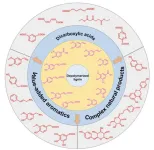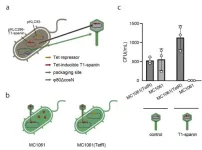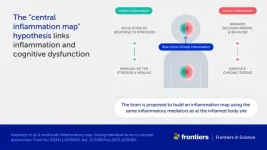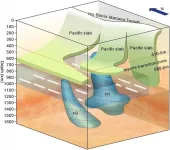(Press-News.org) MINNEAPOLIS / ST. PAUL (03/12/2024) - Researchers at the University of Minnesota Twin Cities may have discovered a mechanical explanation for instability observed in the lungs in cases of acute respiratory distress syndrome (ARDS), particularly in the aftermath of respiratory illnesses such as COVID-19 or pneumonia.
The research was recently published in the Proceedings of the National Academy of Sciences (PNAS), a peer reviewed journal of the National Academy of Sciences.
Currently, there is no known cure for ARDS, a life-threatening lung injury that allows fluid to leak into the lungs. The researchers in this study say that as many as two thirds of all patients that passed away from COVID-19 had ARDS. There is not a clear reason on why specific people with a severe respiratory illness may develop ARDS, while others may not, but researchers in this study were looking to find that answer.
They identified the concentration of a lysolipid—a byproduct of the immune response to viruses and bacteria—that can have a major impact in adults suffering from ARDS. Increased concentration of this chemical eliminates the surfactant, a complex composed of fats and proteins generated in the lungs. The result is uneven lung inflation and, ultimately, respiratory distress in adults.
“This study looked into the correlation of the concentration of the lysolipid in the lungs. Once that fluid reached a certain level, it started to cause severe impacts,” said University of Minnesota Department of Chemical Engineering and Materials Science Professor Joseph Zasadzinski and lead professor on the research.
“Your average everyday person usually won't need to think about this, but if a virus or infection is bothering your lung surfactant system and you end up in the hospital, then it could become top of mind very quickly,” Zasadzinski added
There are a natural amount of these lysolipids that exist in the human body, and as long as those stay below a specific concentration, the average person can breathe normally. When someone has a bad infection, those lysolipids increase, which can lead to respiratory distress. Once a patient is headed in that direction, there are not many ways of reversing those symptoms.
“This research shows frequency dependence, or how quickly you open and close the lungs. This could help doctors try to tailor the treatment process for each specific patient,” said Clara Ciutara, a 2023 Ph.D. chemical engineering and materials science graduate and first author of the study.
Previous research of neonatal respiratory distress syndrome (NRDS) in premature infants found that it could be treated by introducing replacement lung surfactant, but that was not the case in adults. It is the amount of lysolipid that determines the outcome of the surfactant in the lungs, not the breakdown of the existing lung surfactant.
The next step in the research will be to translate these ideas into a clinical environment and test to see if they can manipulate specific molecules to make them less active or stick to a specific place. This could help drop the concentration of the lysolipids to a threshold that may be able to reverse symptoms of ARDS and put people on the road to recovery.
In addition to Zasadzinski and Ciutara, the research team included University of Minnesota Department of Chemical Engineering and Materials Science NIH postdoctoral fellow Steven V. Iasella, undergraduate student Boxun Huang, and former postdoctoral associate Sourav Barman.
This work is supported by a grant from National Institutes of Health (NIH) Heart, Lung, and Blood Institute. All microscopy images were obtained at the University Imaging Center at the University of Minnesota.
To read the entire research paper entitled “Evolution of interfacial mechanics of lung surfactant mimics progression of acute respiratory distress syndrome,” visit the Proceedings of the National Academy of Sciences (PNAS) website. A commentary piece on the research can also be found on the PNAS website.
END
Study provides new insights into deadly acute respiratory distress syndrome (ARDS)
Mechanical explanation for instability in the lungs could lead to new treatments for illnesses such as COVID-19
2024-03-12
ELSE PRESS RELEASES FROM THIS DATE:
Valorization of depolymerized lignin using microorganisms
2024-03-12
Lignin is an abundant natural polymer which is eliminated as a byproduct in the pulp and paper industry. A recent review article explored different microbial processes available for sustainable lignin valorization, yielding not only environmental, but also economic benefits. Researchers highlighted the current advancements as well as challenges faced while using naturally occurring and engineered microbes to transform depolymerized lignin into valuable high-value products.
The increasing focus on transitioning to a low-carbon ...
Exploring the bactericidal activity of T1-spanin against drug-resistant bacteria
2024-03-12
Given the worldwide prevalence of drug-resistance bacteria, the research fraternity is on the lookout for alternative bactericidal treatment approaches. In a recent study, Japanese researchers have now compared bacteriophage-derived enzymes for combating drug-resistant bacteria. Examination of T1-spanin revealed that it shows superior bactericidal activity against various strains, including E.coli. Furthermore, a novel phage-based technology effectively delivers T1-spanin genes into target bacteria. This breakthrough holds promise for the development of ...
Chronic stress and inflammation linked to societal and environmental impacts in new study
2024-03-12
From anxiety about the state of the world to ongoing waves of Covid-19, the stresses we face can seem relentless and even overwhelming. Worse, these stressors can cause chronic inflammation in our bodies. Chronic inflammation is linked to serious conditions such as cardiovascular disease and cancer – and may also affect our thinking and behavior.
A new hypothesis published in Frontiers in Science suggests the negative impacts may extend far further.
“We propose that stress, ...
Rice paddy snake diversification was driven by geological and environmental factors in Thailand, molecular data suggests
2024-03-12
LAWRENCE, KANSAS — A University of Kansas study of rice paddy snakes in Southeast Asia gives key details to their diversification and natural history, adding molecular evidence that the rise of the Khorat Plateau and subsequent environmental shifts in Thailand may have altered the course of the snakes’ evolution some 2.5 million years ago. The findings were published today in the journal Scientific Reports.
Researchers say the implications could help tell the story of diversification more broadly in the region.
“This paper concerns mud snakes ...
Mars attracts: How Earth’s interactions with the red planet drive deep-sea circulation
2024-03-12
Scientists from the Universities of Sydney and Sorbonne University have used the geological record of the deep sea to discover a connection between the orbits of Earth and Mars, past global warming patterns and the speeding up of deep ocean circulation.
They discovered a surprising 2.4-million-year cycle where deep currents wax and wane which, in turn, is linked to periods of increased solar energy and a warmer climate.
The study, published in Nature Communications, tackles the questions of how geological-timescale climate ...
The surprising effect of presence hallucinations on social perception
2024-03-12
If you had to estimate the number of people in a room, without counting them one-by-one, by nature you would overcount them. That’s because, simply put from a Darwinian perspective of how we have evolved, it’s better to overcount potentially harmful agents and predators than to underestimate them. This overcounting social behaviour is shown to be true in humans as well as animals. It’s certainly better to detect too many tigers (even if absent) during a jungle excursion than to miss a hungry one!
Now, EPFL neuroscientists show that if you experience hallucinations, especially ...
Seismological study shows ancient lower mantle flow field under Philippine sea plate
2024-03-12
Researchers from China and Japan have discovered distinct characteristics of the lower mantle flow field. They investigated seismic anisotropy in the upper part of the lower mantle beneath the Philippine Sea Plate (PSP) and found that the ancient lower mantle flow field is still preserved there.
The study was published in Nature Geoscience.
The lower mantle is an important layer of the Earth and may play an important role in the evolution and material cycling of Earth's interior. It is generally believed to be not only the final destination of subducted slabs, ...
Age-related changes in skin may contribute to melanoma metastases
2024-03-12
*EMBARGOED UNTIL TUESDAY, MARCH 12, AT 6 A.M. ET
Age-related changes that cause the skin to stiffen and become less elastic may also contribute to higher rates of metastatic skin cancer in older people, according to research by investigators from the Johns Hopkins Kimmel Cancer Center.
The study, published March 12 in Nature Aging, shows that increased stiffness in aging skin increases the release of a protein called ICAM1. Increased ICAM1 levels stimulate blood vessel growth in the tumor, helping it grow. It also makes the blood vessels “leaky,” enabling tumor cells ...
A coral superhighway in the Indian Ocean
2024-03-12
Despite being scattered across more than a million square kilometres, new research has revealed that remote coral reefs across the Seychelles are closely related. Using genetic analyses and oceanographic modelling, researchers at Oxford University demonstrated for the first time that a network of ocean currents scatter significant numbers of larvae between these distant islands, acting as a ‘coral superhighway.’ These results are published today in Scientific Reports.
Dr April Burt (Department of Biology, University of Oxford, and Seychelles Islands Foundation), lead author of the study, said: ‘This discovery is very important because a key factor ...
Scientists develop a rapid gene-editing screen to find effects of cancer mutations
2024-03-12
CAMBRIDGE, MA -- Tumors can carry mutations in hundreds of different genes, and each of those genes may be mutated in different ways — some mutations simply replace one DNA nucleotide with another, while others insert or delete larger sections of DNA.
Until now, there has been no way to quickly and easily screen each of those mutations in their natural setting to see what role they may play in the development, progression, and treatment response of a tumor. Using a variant of CRISPR genome-editing known as prime editing, MIT researchers have ...
LAST 30 PRESS RELEASES:
Numbers in our sights affect how we perceive space
SIMJ announces global collaborative book project in commemoration of its 75th anniversary
Air pollution exposure and birth weight
Obstructive sleep apnea risk and mental health conditions among older adults
How talking slows eye movements behind the wheel
The Ceramic Society of Japan’s Oxoate Ceramics Research Association launches new international book project
Heart-brain connection: international study reveals the role of the vagus nerve in keeping the heart young
Researchers identify Rb1 as a predictive biomarker for a new therapeutic strategy in some breast cancers
Survey reveals ethical gaps slowing AI adoption in pediatric surgery
Stimulant ADHD medications work differently than thought
AI overestimates how smart people are, according to HSE economists
HSE researchers create genome-wide map of quadruplexes
Scientists boost cell "powerhouses" to burn more calories
Automatic label checking: The missing step in making reliable medical AI
Low daily alcohol intake linked to 50% heightened mouth cancer risk in India
American Meteorological Society announces Rick Spinrad as 2026 President-Elect
Biomass-based carbon capture spotlighted in newly released global climate webinar recording
Illuminating invisible nano pollutants: advanced bioimaging tracks the full journey of emerging nanoscale contaminants in living systems
How does age affect recovery from spinal cord injury?
Novel AI tool offers prognosis for patients with head and neck cancer
Fathers’ microplastic exposure tied to their children’s metabolic problems
Research validates laboratory model for studying high-grade serous ovarian cancer
SIR 2026 delivers transformative breakthroughs in minimally invasive medicine to improve patient care
Stem Cell Reports most downloaded papers of 2025 highlight the breadth and impact of stem cell research
Oxford-led study estimates NHS spends around 3% of its primary and secondary care budget on the health impacts of heat and cold in England
A researcher’s long quest leads to a smart composite breakthrough
Urban wild bees act as “microbial sensors” of city health.
New study finds where you live affects recovery after a hip fracture
Forecasting the impact of fully automated vehicle adoption on US road traffic injuries
Alcohol-related hospitalizations from 2016 to 2022
[Press-News.org] Study provides new insights into deadly acute respiratory distress syndrome (ARDS)Mechanical explanation for instability in the lungs could lead to new treatments for illnesses such as COVID-19









